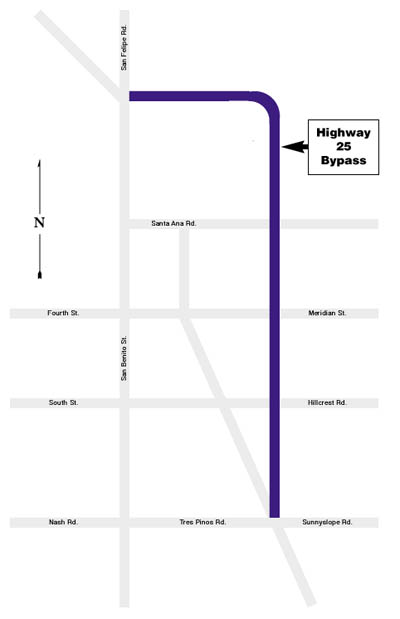
Construction on the long-awaited Highway 25 bypass could begin
by the summer of 2004 now that plans have passed a series of
environmental reviews.
Construction on the long-awaited $25 million Highway 25 Hollister Bypass project could begin by the summer of 2004 now that plans for the roadway have passed a series of environmental reviews.
“We’re on the verge of actually making it happen,” said Rob Mendiola, interim executive director of the Council of SBC Governments.
Mendiola updated COG directors Thursday night on the project’s continued progress.
Mendiola told the COG Board the project received approvals from several different agencies regarding its effect on the local environment.
The approvals included a report stating the roadway project did not present a threat to local air quality. Another assessment indicated noise levels from traffic on the bypass would fall within acceptable levels.
COG officials, working with Caltrans and the National Marine Fisheries Division, have developed an acceptable plan to deal with water runoff from the bypass that might spill into the Santa Ana Creek.
Mendiola said it appeared all that is needed now to get the project underway is approval from the Federal Highway Administration and the U.S. Fish and Wildlife Service.
“It appears we’re on schedule for late next summer,” Mendiola said.
The bypass was first publicly considered in the 1959 Hollister General Plan as a way of reducing the then rising level of traffic congestion in the downtown area.
The 2.6-mile stretch of roadway, which has been debated for 40 years, calls for the construction of a four-lane section of roadway that would extend east from the Bolsa-San Felipe Road intersection about a quarter of a mile, then run south crossing Santa Ana Road, Meridian Street, Hillcrest Road. From there, the bypass would become a six-lane roadway and connect with Airline Highway at the Sunnyslope Tres Pinos Road intersection.
Part of the money for the bypass would come from Measure A funds. The measure is one of the biggest highway and mass transit bill ever approved. The remaining funds would come from a combination of State Transportation Improvement funds, $7 million; Traffic Mitigation Fees, $7.3 million; about $2.4 million in various impact fees and another $2.2 million from other traffic grants.
Construction was delayed when officials had to get an additional $2.25 million in federal funds to pay for the project.
However, in using federal funds, the project must be held to federal environmental standards set up in the National Environmental Quality Act.
Officials said that delayed construction plans because COG had to complete a new environmental review similar to an environmental impact report.
Under federal regulations, the new environmental review has to be taken to any government agency that may be affected by the project and receive each agency’s approval before construction could begin.
Part of that review included a study of the possible impact the bypass may have on the return of steelhead trout to Santa Ana Creek.









